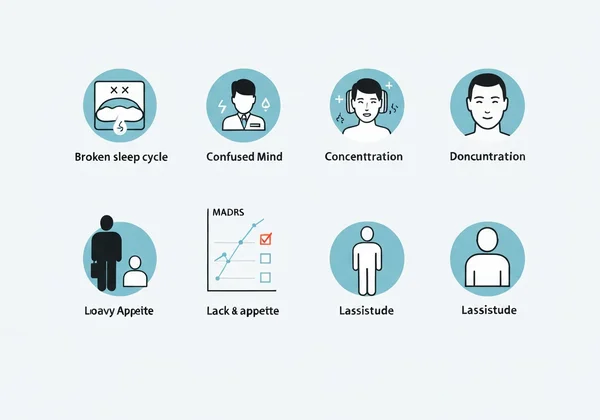Major Depression: 10 Core Symptoms & MADRS Insight
Feeling more than just "sad"? It's a common experience to feel down, but sometimes, that feeling deepens into something more persistent and overwhelming. Many people struggle to put a name to these complex emotions, wondering if what they're experiencing are the signs of clinical depression. Navigating complex emotions can be challenging; this guide aims to bring clarity. We will explore the 10 core symptoms of Major Depressive Disorder and introduce a clinically trusted tool, the MADRS, to help you understand them. What are the 10 questions on the MADRS and how can they offer insight? Let's find out.

Taking charge of your emotional well-being begins with a vital first step. With a structured approach like the MADRS assessment, you can begin to quantify these feelings in a way that is both meaningful and easy to understand.
What is Clinical Depression? Defining Major Depressive Disorder
It's vital to distinguish between a passing low mood and clinical depression, also known as Major Depressive Disorder (MDD). While everyone feels sad or unmotivated at times, MDD is a persistent medical condition that significantly impacts your daily life, from your work and relationships to your physical health.
Unlike temporary sadness, the symptoms of MDD last for at least two weeks and represent a noticeable change from your previous level of functioning. Recognizing this distinction is the key to understanding when it's time to seek support.
Beyond "Feeling Blue": Understanding the Depth of MDD
Clinical depression is not a sign of weakness or something you can simply "snap out of." It is a complex mood disorder with psychological, biological, and social roots. It creates a persistent feeling of sadness or a loss of interest in activities you once enjoyed. This can lead to a variety of emotional and physical problems, making it difficult to function at home and at work. Understanding its depth helps remove stigma and encourages a more compassionate approach to mental health.
Why Early Recognition of Signs is Crucial for Support
Recognizing the early signs of depression is a brave and crucial step towards regaining control of your well-being. Early recognition allows for timely intervention, which can significantly improve outcomes and reduce the long-term impact of the disorder. When you can name what you are feeling, you are better equipped to communicate your needs to loved ones and healthcare professionals. This self-awareness empowers you to take control of your well-being and begin the journey toward recovery.

The 10 Core Symptoms of Depression & How MADRS Assesses Them
The Montgomery-Åsberg Depression Rating Scale (MADRS) is a clinical "gold standard" used by healthcare professionals worldwide to measure the severity of depressive episodes. It consists of 10 questions, each designed to evaluate a core symptom of depression. Here’s a breakdown of those symptoms and how the MADRS helps assess them. You can gain a clearer understanding of these by taking our online tool.
Apparent Sadness: Observable Signs of Dejection
This symptom relates to how depression appears to others. It’s the observable melancholy, gloom, and despondency that can be seen in your facial expressions, posture, and tearfulness. MADRS Item 1 assesses this visible sadness, providing an objective measure of how your mood is being projected outwardly. It helps capture the signs that you might not even be fully aware of yourself but are apparent to those around you.
Reported Sadness: Your Own Feelings of Despair
While the first item is about what others see, this one is about what you feel inside. MADRS Item 2 delves into your subjective experience of sadness, despair, and hopelessness. It asks you to reflect on your internal emotional state. This is crucial for a comprehensive self-assessment, as it honors your personal experience as a valid and central part of the evaluation.
Inner Tension: The Unspoken Unease and Anxiety
Depression isn't just about sadness; it often coexists with feelings of anxiety, restlessness, and inner turmoil. MADRS Item 3 measures this inner tension. It assesses feelings of ill-defined discomfort, edginess, and mental anguish that can be incredibly distressing. Recognizing this symptom is important because anxiety can significantly worsen the experience of depression.

Reduced Sleep: Changes in Your Rest Patterns
Sleep disturbances are a hallmark of depression. This can manifest as difficulty falling asleep, waking up in the middle of the night, or sleeping excessively. MADRS Item 4 evaluates the quality and duration of your sleep. Whether you're getting too little or too much rest, changes in your sleep patterns are a key biological indicator of depression and can have a major impact on your energy and mood monitoring.
Reduced Appetite: Loss of Desire for Food
Similar to sleep, your appetite can be significantly affected by depression. Many people experience a loss of interest in food, leading to weight loss. For others, the opposite occurs, and they may overeat as a coping mechanism. MADRS Item 5 assesses any changes in your appetite. This physical symptom is often a clear signal that your body is being impacted by your mental state.
Concentration Difficulties: Struggling to Focus
Do you find it hard to read a book, follow a conversation, or make decisions? Concentration difficulties are a common cognitive symptom of depression. MADRS Item 6 evaluates your ability to focus and maintain attention. This "brain fog" can be frustrating and can affect your performance at work or school, highlighting how depression impacts more than just your mood.
Lassitude: Profound Tiredness & Lack of Drive
Lassitude is more than just feeling tired; it’s a profound sense of weariness and a lack of energy that makes even small tasks feel monumental. MADRS Item 7 measures this deep-seated fatigue and difficulty getting started with daily activities. This symptom can be debilitating, as it drains you of the physical and mental energy needed to engage with life.
Inability to Feel: Loss of Emotional Response
Often described as feeling "numb," this symptom is a reduced ability to experience pleasure or react emotionally to things you once cared about. Its clinical term is anhedonia, and understanding the Anhedonia meaning is key. MADRS Item 8 assesses this loss of feeling. It's one of the most distressing symptoms, as it can make you feel detached from your loved ones and the world.
Pessimistic Thoughts: Feelings of Guilt & Worthlessness
Depression can change your thought patterns, trapping you in a cycle of negativity. You may experience feelings of guilt, self-reproach, or worthlessness. MADRS Item 9 evaluates the presence of these pessimistic thoughts. These thoughts are often distorted and do not reflect reality, but they feel incredibly real and can severely damage your self-esteem.
Suicidal Thoughts: When Life Feels Not Worth Living
This is the most serious symptom of depression. It ranges from feeling that life is not worth living to making concrete plans for ending your life. MADRS Item 10 assesses the presence and severity of suicidal ideation. If you are experiencing these thoughts, it is essential to seek immediate professional help. You are not alone, and help is available.
Understanding Your Symptoms: How Our Platform Can Help
Recognizing these symptoms in yourself or a loved one is a courageous first step. The next step is to gain a clearer perspective on their severity. This is where our free MADRS test can provide valuable insight, translating your experiences into a structured score.
Getting a Clear Picture with the Free Online MADRS Test
Navigating mental health can feel confusing, but a tool like the MADRS provides a clear, objective framework. By answering the 10 targeted questions on our platform, you can receive an immediate score that helps quantify your symptom severity. Taking the free MADRS assessment is a confidential, accessible way to check in with yourself from the comfort of your own home.

Beyond the Score: Insights from Your Personalized AI Report
A score is a number, but what does it really mean for you? With our MADRS assessment, you have the option to receive a personalized AI-generated report. This report goes beyond the score to provide deeper insights into your results. It can help identify your unique strengths and challenges, explain how your symptoms might be impacting your daily life, and suggest actionable, evidence-based steps you can consider.
Empowering Your Mental Health Journey: From Recognition to Action
Understanding the 10 core symptoms of depression is a powerful act of self-awareness. It transforms vague feelings of distress into recognizable signs that can be addressed. Recognizing these signs in yourself is not a sign of failure but a brave first step toward understanding and healing.
Now that you have this knowledge, you can take the next step. We encourage you to take the first step on our website. The free, confidential MADRS assessment can provide you with a structured evaluation of your symptom severity, offering the clarity you need to move forward.
A note on your well-being: This platform is an informational tool and does not provide a medical diagnosis. The results should not be used as a substitute for professional medical advice, diagnosis, or treatment. Always seek the advice of your physician or another qualified health provider with any questions you may have regarding a medical condition.
Frequently Asked Questions About Depression & MADRS
What is the main purpose of the MADRS scale?
The primary purpose of the MADRS scale is to measure the severity of depressive symptoms and to track changes over time, especially in response to treatment. It is a tool used by clinicians to get a standardized, objective score, and it can also be used by individuals to gain insight into their own emotional state.
Can I use the MADRS for self-assessment?
Yes, the MADRS is an excellent tool for self-assessment. It helps you reflect on your feelings in a structured way and can provide a valuable snapshot of your current mental health. However, it is not a diagnostic tool. The results should be used to open a conversation with a healthcare professional, not to self-diagnose.
Is the online MADRS test free?
Absolutely. The 10-question MADRS assessment on our platform is completely free, and you will receive your score instantly upon completion. We believe everyone should have access to high-quality tools for understanding their mental well-being. You can get your free score today.
How do I interpret my MADRS score after taking the test?
After you complete the assessment, our platform provides an immediate score along with a general interpretation of what the score range typically indicates (e.g., mild, moderate, or severe symptoms). For a more detailed, personalized breakdown, you can opt for our AI-powered report. For a clinical interpretation, it's always best to discuss your score with a doctor or mental health professional.
What should I do if I recognize these symptoms in myself or a loved one?
If these symptoms resonate with you, the most important thing to do is talk to someone. This could be a trusted friend, family member, or a healthcare professional. Using a tool like the MADRS can help you organize your thoughts before that conversation. Remember, seeking help is a sign of strength.